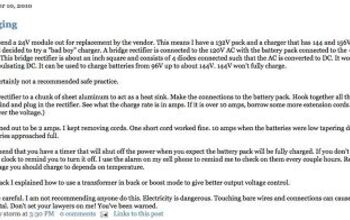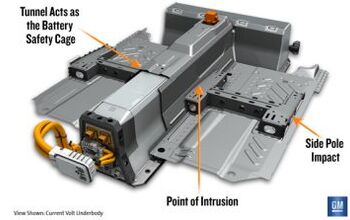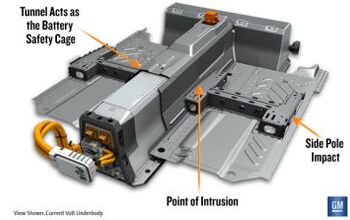Volt And Consequences: GM Responds To NHTSA Volt Investigation
With NHTSA opening a formal defect investigation into the Chevy Volt, GM is moving to defend its rolling lightning rod (no pun intended) and allay consumer fears about its safety. Yesterday I briefly appeared on Fox Business’s Your World With Neil Cavuto show to talk about what the intro to my segment referred to as “the hybrid from hell” and the “killer in your garage.” I tried to explain that the danger to consumers was basically nil, and that the real concern is for rescue, towing and salvage workers. And I would have explained why NHTSA’s tests still leave some serious questions open, but my “fair and balanced” approach meant that my segment ended up being extremely short. So let’s take the opportunity now to look past the hysteria and pinpoint the real issues with NHTSA’s investigation into the Volt.
A recent GM press release on the issue was accompanied by a conference call to reporters [transcript in .doc format here], in which GM’s top product executives, North American President Mark Reuss and Product Development Boss Mary Barra, gave GM’s perspective on the flap. But in a key passage, Barra confirmed that the most reasonable criticism of GM is essentially legitimate, as she confirmed that GM had not fully developed post-crash safety procedures before putting the Volt on the market.
Three weeks after the [initial NHTSA side-pole] test, the Volt caught fire. This vehicle crash test was conducted before GM had finalized its battery depowering procedure. We have learned that significant electrical charge, or energy, was left in the battery after the test. When electrical energy is left in a battery after a severe crash it can be similar to leaving gasoline in a leaking fuel tank after severe damage. It’s important to drain the energy from the battery after a crash that compromises the battery’s integrity – or you risk potential fire.
That’s why we have developed a process to depower the Volt’s battery after a severe crash. We have been using the protocol since July of this year and we have now shared this process with the NHTSA and are working to extend this process and the needed equipment to those who handle or store vehicles after a severe crash.
Unable to deny that it should have had post-crash protocols in place before launching its first lithium-ion battery-powered car, GM seems to be trying to broaden the issue to extend beyond the Volt. Said Barra
But I also have to put this into the proper perspective: Battery safety isn’t just a Volt issue. This is an issue we’re already working within the industry. In fact, we are currently leading a joint electric vehicle activity with the Society of Automotive Engineers and other automotive companies to address new issues such as a process and protocol for depowering batteries.
The problem is, this does appear to be a Volt issue. Between the Nissan Leafs already on the road and the Prius Plugins that Toyota has been testing for years now, there are no documented thermal events that I’m aware of. Furthermore, the loss of battery integrity that the Volt experiences in side impacts seems to be caused by the lack of a steel battery case, which Nissan fits to its Leafs. Though it’s not clear what post-crash procedures Nissan has proliferated, it seems that its decision to protect its batteries with steel casings maintains battery integrity in government crash testing, eliminating the risks seen in the Volt.
Meanwhile, there is one question that nags at me. In the wake of the June fire at a NHTSA facility, GM shared its post-crash safety protocols. But the latest Volt fire, which happened a week after NHTSA, DOE, DOD and GM engineers test-ruptured a Volt battery, “ sparked a fire of a wooden structure” at the DOD’s Hampton Roads facility. Here’s what’s not clear: whether that battery pack was subjected to GM’s post-crash protocols. If it was, this fire proves that GM doesn’t have a handle on this problem, and that its safety procedures are insufficient. If the post-crash protocols were not followed, NHTSA, DOE and DOD were incredibly stupid to store a battery pack they knew might catch fire in a wooden building. Furthermore, GM’s communications team has yet to clarify whether this latest fire was caused because safety procedures were not followed intentionally. One way or another, this needs to be clarified, even if it makes the government testers look foolish.
Based on GM’s reaction, deploying top executives, offering loaner cars, and vigorously defending the Volt in the press, it’s clear that The General takes this situation incredibly seriously… which is why I’m a little shocked that it hasn’t cleared up the circumstances of the most recent fire. After all, the Volt is easily the most controversial car in America, and based on my experience on Cavuto yesterday, it’s clear that many hope to use this investigation as the final nail in its coffin. But there is still much we don’t know about these thermal events, and what we do know indicates that they are not an immediate danger to owners and drivers.
So where is the danger? Clearly to the afore-mentioned rescue, salvage and towing workers… but also to the Volt’s sales. The Volt already has marketing challenges based on its price and association with the bailout. Even the hint of a fire risk is going to add the Volt’s sales headwind, making it even tougher to meet its goal of selling 45,000 units in the US next year. Meanwhile, the White House’s goal of putting 120k Volts on the road next year is pushed even further out of reach.
In short, this does not appear to be the death blow that Volt-bashers were hoping for, and GM appears to be handling the situation as well as can be expected. But this incident does highlight the downsides to pioneering new technologies, and shows how just one overlooked detail can create huge PR issues.
More by Edward Niedermeyer
Latest Car Reviews
Read moreLatest Product Reviews
Read moreRecent Comments
- Marcr My wife and I mostly work from home (or use public transit), the kid is grown, and we no longer do road trips of more than 150 miles or so. Our one car mostly gets used for local errands and the occasional airport pickup. The first non-Tesla, non-Mini, non-Fiat, non-Kia/Hyundai, non-GM (I do have my biases) small fun-to-drive hatchback EV with 200+ mile range, instrument display behind the wheel where it belongs and actual knobs for oft-used functions for under $35K will get our money. What we really want is a proper 21st century equivalent of the original Honda Civic. The Volvo EX30 is close and may end up being the compromise choice.
- Mebgardner I test drove a 2023 2.5 Rav4 last year. I passed on it because it was a very noisy interior, and handled poorly on uneven pavement (filled potholes), which Tucson has many. Very little acoustic padding mean you talk loudly above 55 mph. The forums were also talking about how the roof leaks from not properly sealed roof rack holes, and door windows leaking into the lower door interior. I did not stick around to find out if all that was true. No talk about engine troubles though, this is new info to me.
- Dave Holzman '08 Civic (stick) that I bought used 1/31/12 with 35k on the clock. Now at 159k.It runs as nicely as it did when I bought it. I love the feel of the car. The most expensive replacement was the AC compressor, I think, but something to do with the AC that went at 80k and cost $1300 to replace. It's had more stuff replaced than I expected, but not enough to make me want to ditch a car that I truly enjoy driving.
- ToolGuy Let's review: I am a poor unsuccessful loser. Any car company which introduced an EV which I could afford would earn my contempt. Of course I would buy it, but I wouldn't respect them. 😉
- ToolGuy Correct answer is the one that isn't a Honda.

































Comments
Join the conversation
Toyota/NHTSA get their revenge on GM? http://www.bloomberg.com/apps/news?pid=newsarchive&sid=ajWwH9o__irY http://www.thetruthaboutcars.com/2010/03/nhtsas-revolving-door-most-automakers-employ-former-staff-members/
How long before the first Volt gets crushed live on TV?.. fully charged of course, it should be spectacular.